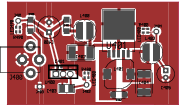 | This is the board before tin plating. It's a small power supply board, with 12v in, and 5v linear and 3.3c switcher regulators. I scrubbed it bright and shiny with a green scrubbing pad and some dish soap, then dried with a paper towel. |
 | This is the setup I'm using. I have a 4oz bottly of MG Liquid Tin, and an old hard drive shipping clamshell. The clamshell is plastic, and just the right size for this procedure. Note that I'm using a bench that's used to being chemically abused. |
 | The 4oz bottle gives me about 1/4 to 3/8 of an inch (half a cm) of fluid, easily enough to cover the board. The board starts changing to tin colored in a few seconds, but it takes the full 3-5 minutes to make sure it's fully covered. |
 | The results, after rinsing and drying. Note that the covering is not 100%. This could be due to poor cleaning, but I tried leaving it in longer and the coating became dark grey and messy. (Note that other times since then I've left it in longer without it getting messy, YMMV) |
 | Now with a silkscreen layer added, again with a simple toner transfer. Note that the toner didn't stick where there wasn't any copper, because those spots are "deeper" than the copper and there wasn't any pressure there from the laminator. It stuck to the tin just fine, though. |
 | Finally, with all the parts soldered on. Some of the through-hole parts are on the other side, like the power connector and electrolytics. The 7805 is on the top because it's easy to solder that way. Both reflow solder (via hotplate) and hand soldering seemed to be unaffected by the tin plating. |
